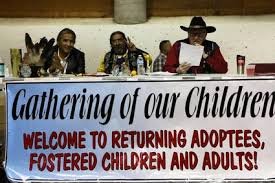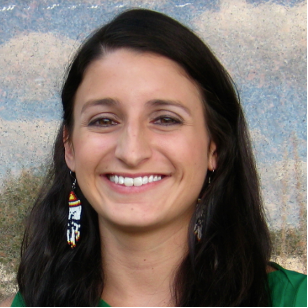Gathering for Our Children and Returning Adoptees Pow Wow
Pow Wow Welcomes Native Adoptees Home
Written by Racheal White Hawk Strong
I’ve been to pow-wows before, but this one was different. The entrance read, “Gathering for our Children and Returning Adoptees.” The annual powwow is in its ninth year at the Minneapolis American Indian Center and is a collaboration between the Department of Human Services, Hennepin County ICWA Unit’s Tina Knafala and Jacque Wilson as well as my Aunt Sandy White Hawk, Director of the First Nations Repatriation Institute. The goal is to reconnect adoptees with their families and culture as well as raise awareness of the need for Native foster/adoptive homes. My heart smiled seeing my Auntie and cousins. For the last several years I’d been on a quest to find the rest of my Lakota family. My mom had largely given up; then again you could say she never really tried.
“They’re like strangers to me. They’re not family. My adoptive family is my real family.”
“Why can’t we have both?” I countered.
“I don’t know! Quit asking!” The unknown is scary for my mom.
My family history follows a common theme in Indian country: assimilation. My mom was one of 9 children born to my Sicangu Lakota grandmother, Nina Lulu White Hawk on the Rosebud Sioux Reservation. Before the protections of the Indian Child Welfare Act (ICWA), social workers broke into my grandmother’s house when she wasn’t home, stole her children and flung them to the winds. Grandma Nina’s only crime was lack of an indoor toilet.
My mom and three of her siblings were placed in an orphanage in Nebraska. Mom recalls being locked in the closet at the orphanage without food or water. When she was sleeping, a social worker stole her stuffed kitten and chucked it into the dumpster because it was a reminder of her previous life. A white family finally adopted my mom and three of her siblings with the command, “Forget your mother. We are your only family now.” They were raised in Custer County, Nebraska, where they were the only Indians except for the school mascot.
None of us were allowed to be Native growing up. My adoptive grandparents painstakingly attempted to hide our biological family from us, but over the years we were able to connect with many of our relatives thanks to Aunt Deb. This year at the annual Rosebud wacipi, I was finally able to meet my mom’s biological sister, Aunt Sandy. And despite my adoptive grandparents’ misguided beliefs that all Native Americans are alcoholic, suicidal, drug abusers, I am immensely proud to be Lakota.
At the Pow Wow I hopped down the bleachers filled with a couple hundred onlookers to join the circle of returning adoptees preparing for the healing ceremony. Suddenly I felt a knot in my throat growing. “Crap,” I thought. “I’m going to cry before the ceremony even starts.” I was there representing my 52-year-old mom, who had refused to come despite my every attempt.
Sage smoke filled the air. I stood with the other adoptees in a circle, surrounded by a ring of jingle dress dancers followed by a ring of veterans. I gazed across the group to see a visibly distraught woman tightly clutching her shawl and choking back sobs. Her eyes were swollen and red from crying.
The drum group started to sing a healing song. The jingle dress dancers began their sacred footwork, waving their eagle feather fans over us. They swayed and dipped. Tingles shot down my spine with every fan that touched my shoulders. Then I lost it. Tears flowed uncontrollably. Every tear represented a moment I felt lost, afraid, angry, frustrated, empty, and confused. Every tear burning down my cheek screamed at those who thought taking us from our family was in our “best interest.” I felt the anger boil up from all the hurtful comments about Natives my adoptive family has said over the years, laughing at me for making regalia. The rage spilled out as I recalled my adoptive Aunt Lila’s comments last month that the “poor, pitiful Indians” still needed saving. But I was comforted by the swish of the jingles mimicking the sound of water, the sound of healing. And slowly my emotional burden started to fade. As the tears fell to the ground, I felt lighter. When the singing stopped, I felt a sense of renewal. Crying is medicine.
After the ceremony, we gathered upstairs for an adoptee talking circle. We each reflected on our experience. Several adoptees commented the powwow was unlike any other they’d been to. Even though so many of our Native children were lost through adoption, many tribes don’t yet have a powwow or ceremony to acknowledge their return. But the adoptees felt welcome at Aunt Sandy’s powwow; they felt like they were finally coming home to a community. One older man commented he felt the gaping, empty hole inside him start to fill up to form a complete person.
Throughout the powwow, I filmed my Aunt Sandy and cousins Dyani, John, and Alicia to familiarize my mom with our biological family and ease her fears. Next year I hope she’ll join us at the powwow, especially for the end of the ceremony when community members streamed down to shake our hands and said with a warm embrace, “Welcome home.”
Racheal White Hawk Strong, enrolled Rosebud Sioux Tribal Member, is the administrative secretary at Nebraska Commission on Indian Affairs, a Native Daughters graduate student, and a former Fulbright Scholar to China.



